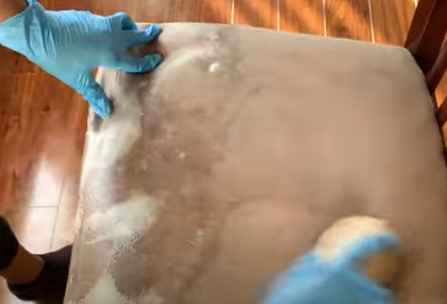The best way to clean an upholstered chair is by vacuuming and spot-cleaning with a suitable upholstery cleaner. Always perform a patch test on an inconspicuous area before applying any cleaner.
Keeping your upholstered furniture in pristine condition not only enhances your home’s aesthetic but also extends the life of your furnishings. Upholstered chairs, in particular, can accumulate dust, spills, and odors, necessitating a thorough but gentle cleaning method.
Whether you’re dealing with light dusting or stubborn stains, mastering the art of upholstery cleaning can save you from costly professional services.
Regular maintenance, including vacuuming with the appropriate attachments and tackling spills immediately, can keep your chairs looking fresh.
A strategic approach, using the right products and techniques, will help maintain your upholstered chair’s vibrant color and comfort for years to come.
Introduction To Upholstered Chair Cleaning
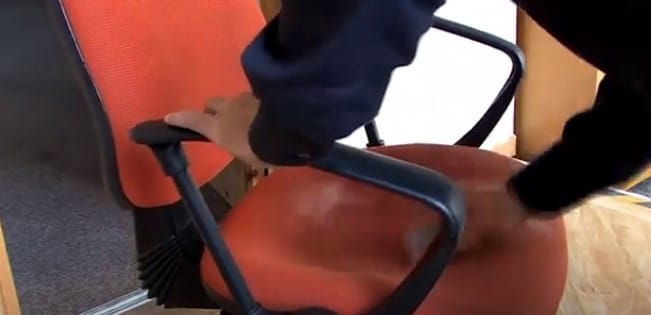
Cleaning an upholstered chair keeps it looking fresh and new. Chairs with fabric coverings attract dust, spills, and odors. Giving them a proper clean extends their life and beauty.
Upholstery Fabric Types
Different fabrics need different care. Check the manufacturer’s label first. The label may have a code that tells you what to use:
- W: Water-based cleaner
- S: Solvent-based cleaner
- WS: Both types of cleaners
- X: Vacuum only
Knowledge of your chair’s fabric type guides the cleaning process. This ensures you don’t damage your chair. If the label is missing, test a small area first.
Significance Of Regular Cleaning
Regular cleaning removes allergens and bacteria from your chair. It can stop stains from setting in too. Clean chairs look better and are safer for everyone.
| Cleaning Frequency | Benefits |
|---|---|
| Weekly Vacuuming | Removes surface dirt and dust |
| Spill Treatment | Prevents stains |
| Professional Cleaning | Deep cleans and maintains fabric integrity |
Spills should be dealt with immediately. The longer a spill sits, the harder it is to remove.
Pre-cleaning Preparation
Cleaning an upholstered chair starts with the right preparation. Before you dive into scrubbing and spot cleaning, setting the stage ensures a smooth and effective cleaning process. Let’s walk through the steps of pre-cleaning preparation to keep your chair looking impeccable.
Gathering Necessary Supplies
To tackle a cleaning project, you need the right tools. Collect these essentials:
- Vacuum cleaner with an upholstery attachment
- Mild detergent suitable for upholstery
- Soft-bristled brush to loosen dirt
- Clean microfiber cloths
- Bucket or bowl for water and detergent mixture
- Gloves to protect your hands
Confirm you have all supplies in your workspace before starting. This keeps the cleaning flow uninterrupted.
Identifying And Testing For Fabric Colorfastness
Your chair’s fabric type is very important. Look for the manufacturer’s label for crucial care instructions. Test any cleaner on an inconspicuous area. Here’s how:
- Dab a small amount of cleaner on a hidden spot.
- Wait a few minutes.
- Blot with a white cloth to see if the color transfers.
No color transfer? You’re good to go. If the fabric shows signs of discoloration, opt for a different cleaning solution.
Vacuuming Techniques For Dust Removal
Dust can turn your once pristine upholstered chair into a dingy eyesore. Regular vacuuming is the easiest and most efficient way to keep it looking as good as new. Let’s dive into how to remove dust without a fuss.
Choosing The Right Vacuum Attachment
To start, identify the appropriate vacuum cleaner attachment for upholstery. Your tool of choice should be:
- Soft-bristled to avoid fabric damage
- Easily maneuverable to reach tight spots
- Designed for gentle suction to prevent pulling on the fabric
An attachment with a flat edge can also help in crevices. Always refer to your vacuum’s manual to pick the best one.
Systematic Vacuuming Strategies
Organized methods lead to thorough dust removal. Begin with this approach:
- Remove all cushions and accessories from the chair.
- Use a crease tool for the nooks and crannies.
- Proceed with top to bottom passes to avoid re-depositing dust.
- Overlap strokes to ensure no spot is missed.
- Replace cushions and vacuum their surfaces.
Regular vacuuming using these tips will extend the life of your upholstered chair and retain its beauty. For best results, vacuum once a week or more, depending on usage. Your chair will thank you!
Spot Cleaning Solutions
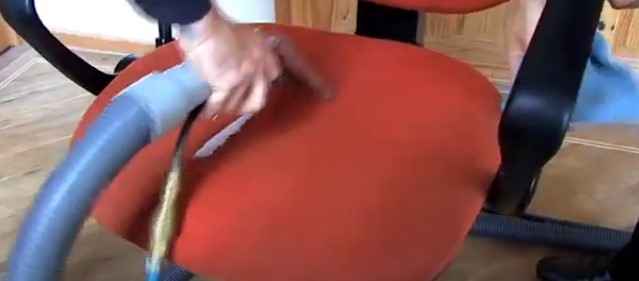
Soiled spots on an upholstered chair need gentle care. Quick action with the right solution can restore your chair’s look. Learn the best spot cleaning methods now.
Diy Spot Cleaning Mixtures
Safe and effective, DIY mixtures use items from your pantry. These mixtures protect fabrics and are kind to your wallet. Try these DIY solutions for swift stain removal:
- Baking Soda Paste: Mix baking soda with water. Apply to the spot. Let it sit. Vacuum it up.
- Vinegar Solution: Combine equal parts white vinegar and water. Blot the stain, don’t rub.
- Dish Soap Mix: Add a drop of dish soap to a cup of water. Dip a cloth in. Dab the stain.
Commercial Cleaners: What To Look For
Selecting a commercial cleaner requires attention to detail. Opt for non-toxic formulas. Check for suitability with your chair’s fabric. Below are key features to consider:
| Feature | Benefit |
|---|---|
| Eco-Friendly Ingredients | Safe for homes, pets, and the planet |
| Fabric Compatibility | Prevents damage to the material |
| No Harsh Chemicals | Keeps colors bright and textures intact |
| Enzymatic Cleaners | Great for organic stains like food or bodily fluids |
Handling Common Stains
Clean upholstery makes any room shine. Accidents happen. Food drips. Oil smears. Regular upkeep keeps chairs looking great. This guide tackles common stains with ease.
Removing Food And Beverage Spills
Act fast with spills to stop stains. Use these steps:
- Blot immediately with a white cloth. Avoid rubbing.
- Mix 2 cups water with 1 tablespoon dish soap.
- Dip a sponge in the solution. Gently dab the stain.
- Rinse with a damp cloth. Pat dry with a towel.
Dealing With Oil And Grease Marks
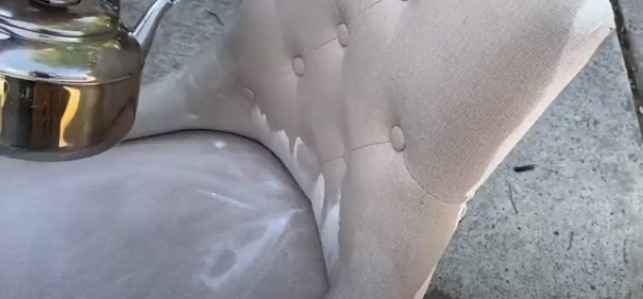
Oil and grease can be stubborn. Follow these steps to remove them:
- Sprinkle baking soda on the mark.
- Wait 10 minutes. Vacuum.
- If the stain persists, use dry cleaning solvent.
- Apply solvent with a clean cloth. Blot gently.
- Let the area air dry.
Deep Cleaning Processes

Maintaining the deep cleaning processes for your upholstered chair ensures it remains a cozy haven. Routine maintenance might keep the surface clean, but what lies beneath requires thorough techniques. Deep cleaning revolves around eliminating deeply embedded dirt, allergens, and stains to rejuvenate your chair’s look and feel. Let’s explore between steam cleaning and dry cleaning methods, and the benefits of hiring professional services.
Steam Cleaning Vs. Dry Cleaning
Both steam cleaning and dry cleaning tackle the grim beneath the fabric, but they work differently.
- Steam Cleaning:
- Uses hot water vapor to penetrate fibers.
- Dissolves and lifts grime effectively.
- Kills bacteria and dust mites.
- Requires drying time.
- Dry Cleaning:
- Employs chemical solvents, no water.
- Safe for delicate fabrics.
- Less drying time needed.
Steam cleaning may be more suitable for durable fabrics, while dry cleaning is best for sensitive materials.
Hiring Professional Cleaning Services
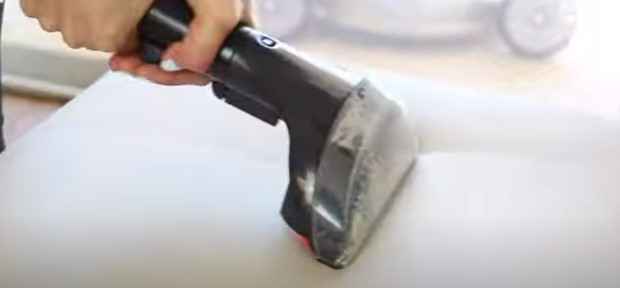
Seeking out professional cleaning services can sometimes be the best action.
| Advantages of Professional Services |
|---|
| Deep expertise in fabric care |
| Possession of high-grade equipment |
| Use of specialized cleaning agents |
| Time-saving and convenient |
| Often includes a satisfaction guarantee |
Professionals bring experience and precision to the task, giving your chair a refreshed look without damaging it.
Caring For Sensitive Upholstery
Caring for an upholstered chair requires a gentle approach, especially when dealing with sensitive materials.
Techniques For Delicate Fabrics
Delicate fabrics need special care. Start by vacuuming with a soft brush attachment to remove dust. Test cleaners on a hidden spot. Use a soft cloth dipped in a mild, soapy solution. Gently blot without rubbing. Dry with a fan or hairdryer on a cool setting.
- Vacuum gently to avoid fabric damage.
- Test all cleaners in an unseen area first.
- Blot carefully, do not scrub or press hard.
- Dry using cool air to prevent shrinking or water marks.
When To Avoid Water-based Cleaners
Certain materials like silk, velvet, and vintage textiles should not be cleaned with water-based products. These fabrics can stain or shrink when water is applied. Instead, opt for a dry cleaning solvent or foam upholstery cleaner. Always respect the manufacturer’s instructions.
| Fabric Type | Cleaner Type |
|---|---|
| Silk | Dry Cleaning Solvent |
| Velvet | Foam Upholstery Cleaner |
| Vintage Textiles | Dry Cleaning Solvent |
On tags, look for the code ‘S’ to confirm solvent-based cleaners are safe. Never skip the manufacturer’s care label. When in doubt, consult a professional furniture cleaner for advice.
- Check cleaning codes on furniture tags.
- Avoid water on ‘S’ labeled fabrics.
- Seek professionals for the best results.
Odor Elimination Methods
Upholstered chairs can be comfy and stylish additions to any room. But unpleasant odors can ruin the experience. Chairs can absorb a variety of smells from pets, spills, and daily use. In our section on Odor Elimination Methods, you’ll discover how to refresh your chair and restore its inviting scent.
Natural Odor Absorbers
Natural solutions offer a safe and eco-friendly way to tackle chair odors. They are easy to use and often found right in your pantry. Try these effective odor absorbers:
- Baking Soda: Sprinkle generously on the chair, let sit for hours, then vacuum.
- Vinegar: Mix with water, spray lightly, and allow to air dry.
- Coffee Grounds: Place in a breathable bag and leave on the chair overnight.
Chemical Deodorizers: Pros And Cons
Chemical deodorizers offer a powerful punch against stubborn odors. However, they can come with drawbacks. Here’s a quick overview:
| Pros | Cons |
|---|---|
|
|
Before using chemical deodorizers, test a small area for any adverse reaction.
Drying And Ventilation Tips
After cleaning your upholstered chair, drying and ventilation are key. The right techniques prevent mold and odors. Let’s explore how to do this effectively.
Safe Drying Techniques
Safe drying starts with absorbing excess moisture. Use a clean, dry towel to gently blot the fabric. Do not rub, as this may damage the upholstery. For deeper drying, you might consider using a hairdryer on a cool setting. Move it back and forth to avoid overheating any area. Make sure to keep the dryer at least 6 inches away from the fabric surface.
In sunny weather, placing the chair outside can help too. Shield it from direct sunlight using a light sheet or blanket to prevent color fading.
Ensuring Proper Airflow
Proper airflow is critical in the drying process. Open windows or use a fan to help air circulate. This can speed up drying and whisk away any lingering dampness.
If using a fan, place it in a way that allows air to reach all sides of the chair. A dehumidifier can also be a great ally in reducing humidity levels. Keep the room’s door open for airflow throughout the house. This encourages even and quick drying.
- Rotate the chair periodically to ensure all parts dry evenly.
- Avoid closing up a damp room, as this can cause mildew.
Post-cleaning Maintenance
Once you’ve brought your upholstered chair back to its pristine condition, ongoing care is key to maintaining its cleanliness. Proper post-cleaning maintenance ensures the chair stays fresh and vibrant for longer.
Routine Spot Checks
Regular inspection plays a crucial role in keeping your chair clean. Here’s how you can do it:
- Weekly Examination: Check the fabric for new spots or dirt.
- Immediate Action: Clean spills and marks as soon as they occur.
- Gentle Cleaning: Use a soft cloth with mild detergent for new stains.
Protective Measures To Prolong Cleanliness
To extend the life and look of your clean chair, consider these protective steps:
- Throw Blankets: Drape them over common contact points to shield fabric.
- Arm Covers: Use them to prevent wear from daily use.
- UV Protection: Keep the chair away from direct sunlight to prevent fading.
- Fabric Protector: Apply a safe product to repel dirt and stains.
Upholstery Protection Strategies
Keeping an upholstered chair clean is more than tackling spills and stains. It’s about preventing damage from the start. Effective upholstery protection strategies save time and preserve your chair’s look and feel.
The Role Of Fabric Protectors
Fabric protectors act as a barrier on upholstered furniture. They repel liquids and prevent dirt from setting into the fibers. Applying a fabric protector is a smart move. It extends your chair’s lifespan and helps in maintaining its original appearance. Be sure to select a protector suitable for the upholstery material. Always test in an inconspicuous area first.
How to Apply Fabric Protector:
- Check the manufacturer’s label.
- Ensure the chair is clean and dry.
- Spray evenly onto the surface from a distance.
- Allow it to dry completely before use.
Avoiding Sunlight And Heat Damage
Sunlight and heat can fade and weaken upholstery fabric. Shield upholstered chairs from direct sun exposure. Using curtains or blinds cuts down the amount of light hitting the furniture. Rotate the chair occasionally to expose all sides evenly to light. This mitigates uneven fading and wear.
Quick Tips to Prevent Sun Damage:
- Close blinds during peak sunlight hours.
- Position chairs away from windows and heat sources.
- Consider UV-blocking window films.
Common Mistakes To Avoid
Keeping an upholstered chair looking fresh can be tricky. Many people make easy mistakes. This guide helps dodge those pitfalls. Knowing what not to do is just as crucial as the cleaning steps. Let’s dive into common missteps that can ruin your efforts.
Overwetting The Upholstery
Too much water on your chair can cause damage. When cleaning, it’s vital to use just enough moisture to clean, not soak. Overwetting can lead to unwelcome issues:
- Mold and mildew
- Stains spreading
- Fabric becoming weak
To prevent these, use a damp cloth rather than a wet one. This helps the chair dry quicker, avoiding damage.
Using The Wrong Cleaning Agents
Not all cleaners are safe for your chair. Some can bleach or discolour the fabric. Others could even ruin the material. If the labels are unclear, spot test in an unseen area first. Here’s a quick guide:
| Fabric Type | Suggested Cleaner |
|---|---|
| Synthetic | Soap-based cleaner |
| Wool | Wool-safe detergent |
| Cotton | Mild detergent |
Always follow the guidelines for your chair’s material. Choosing the right cleaner is critical to prevent damage.
Frequently Asked Questions For What’s The Best Way To Clean An Upholstered Chair
Can You Steam Clean Upholstered Chairs?
Yes, steam cleaning is an effective method to clean upholstered chairs. It removes dirt, kills germs, and refreshes the fabric. However, check the manufacturer’s instructions for material compatibility to prevent damage.
What Cleaning Solution Works For Upholstered Furniture?
For general cleaning, a solution of mild dish soap and water often works well for upholstered furniture. You can also use a mixture of vinegar and baking soda for tougher stains. Always test a small, inconspicuous area first.
How Often Should I Clean My Upholstered Chair?
It’s advisable to do a routine vacuuming of your upholstered chair weekly and conduct a deep clean every 3 to 6 months. However, immediate spot cleaning is recommended when spills occur to prevent stains.
Is It Safe To Use A Hairdryer To Dry Upholstery?
Using a hairdryer on a cool setting can safely speed up the drying process of upholstery after cleaning. Keep it at a distance to avoid watermarks and ensure the fabric isn’t subjected to excessive heat.
How Do You Clean Upholstered Chairs With Baking Soda?
To clean upholstered chairs with baking soda, begin by sprinkling a generous amount of baking soda over the surface of the chair. Allow it to sit for at least 15 minutes to absorb odors and freshen the fabric.
Conclusion
Maintaining a spotless upholstered chair doesn’t have to be daunting. With the right approach, you can tackle stains and refresh fabric with ease. Remember, regular care extends your chair’s life and keeps it looking its best. So, grab your cleaning supplies and show your chair some love today!

